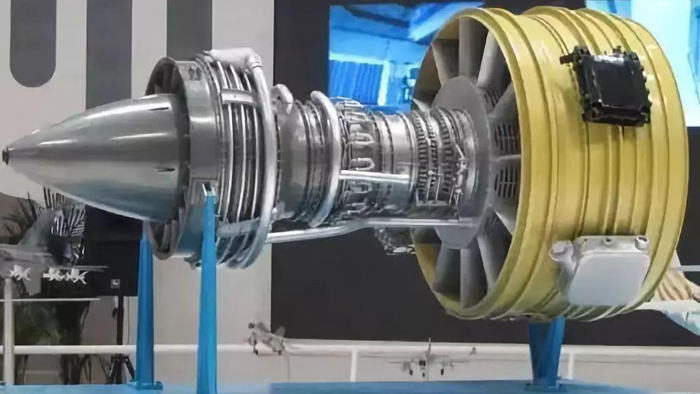Home >> NEWS >> Industry News
Titanium is used in foreign aviation jet engines |
The aerospace industry is the main use of titanium, and jet engines are an important part of the main use of titanium. According to the statistics of the United States, from 1959 to 1973, the United States jet engine manufacturing industry used titanium accounted for 37% to 50% of the total consumption of the country, and the amount of titanium used in small subsonic jet engines accounted for 1/3 of its total mass. In aero-engine, the medium-temperature component made of titanium material has higher fatigue strength, yield degree, creep strength and lower elastic modulus than steel material, so it can reduce the stress under fatigue load. Titanium alloys have high corrosion resistance and can greatly reduce the compression performance of jet engines. By increasing the pressurization ratio of engine compressor and the gas temperature of turbine inlet, the total efficiency of engine can be improved, thus increasing engine thrust, improving thrust-to-weight ratio and reducing fuel consumption. The total pressure ratio of engine compressors in the United States and Britain increased from 10-13 in the early 1960s to 20-27 in the 1970s, and is rising year by year, and the total pressure is expected to increase to 50. Without cooling technology, the temperature of turbine inlet of multi-role fighter has already exceeded 1650℃. 
Because of harsh working conditions and engine size increased, light alloy and stainless steel is difficult to do, so the consumption is not, and titanium alloys and high temperature alloy due to its reduced production costs, the continuous improvement of processability, and adopting new technology, its advantage more and outstanding, in the application of the engine increases year by year. From 1950 to 1980, the materials used for several major aircraft engines in the United States are summarized in the following table. Pratt & Whitney's jet engines use 7% to 15% of their weight in titanium, while GE's J73 jet uses 6% in titanium. The J79 rotor used to have a 17-grade stainless steel rotor, but was later converted to an 11-grade titanium rotor. The J79-8 engine uses 20 percent titanium and the J79-3 engine uses 4 percent titanium. The use of titanium in aircraft engines in the United States began in 1954, when the B52 bomber was equipped with four titanium engines, J57, using 7% to 15% titanium material, intake brake and low pressure brake using industrial pure titanium, low pressure compressor blades, plates and plates are ti-6Al-4V alloy. JT3D turbofan engine uses 15% titanium: Low-pressure compressor fan blades, blade partitions and fan valves are all Ti-6Al-4V, and fan blades are 406mm long, more than twice as long as compressor blades. Because these components are made of titanium alloy, the engine performance is greatly improved. The JT9D engine fan blade is 711 mm long, almost 10 times longer than the compressor blade. The military JT3D variant and TF33 engines use 2% titanium. The amount of titanium used in JT9D turbofan engine accounts for 28% of its total mass, about 1.035T. Its 46 fan blades are made of Ti-6Al-4V alloy. The low-pressure compressor rotor and the 9-stage of the 11-stage high-pressure compressor are made of Ti-6Al-4V, Ti-8Al-1Mo-1V, Ti-6Al-2Sn-4Zr-2Mo alloy, the latter alloy is a high-temperature alloy, the working temperature is 480℃, the dosage is 450kg, the stator cotyledon is ti-5AI-2.5Sn, The modified JT9F engine uses 4.5 tons of titanium, which accounts for 5% of the engine cost. The titanium material used in TF39 fan engine reaches 33%, which is equipped with C5A military transport plane and weighs about 3T. The compressor disc and blade are made of Ti-6Al-4V and TI-5AI-2.5Sn. The compressor blank is forged, and the original weight is 312kg, which is reduced to 126kg by fine forging. Only 5.7kg after forging. GE4 turbojet engine has a total weight of about 5T and uses 10% titanium. Ti-6al-2sn-4zr-2mo alloy is used in the first four stages of hollow compressor. It is a kind of high creep alloy and its working temperature can reach 500℃, 100℃ higher than that of Ti-6Al-4V alloy. Using titanium instead of steel to manufacture some components of lift engines can improve the thrust-to-weight ratio, for example, the Japanese JR100 engine compressor and turbine used to be made of steel, but the JR200 engine made of titanium alloy and heat-resistant aluminum alloy has increased the thrust-to-weight ratio from 10 to 16. KS150 alloy (Ti-5AI-2CR-1Fe) is used to manufacture the first compressor blade, front axle, compressor disc, rear axle and disc of the turbine. The static blade of the compressor is made of Ti-6Al-4V alloy instead of Cr12 stainless steel, which reduces the mass by 43%. In Russia, the HK8 turbofan engine for the Il-62 transport uses about 40% of its mass titanium alloy, as does the HK144 turbofan engine for the Tu-144 supersonic transport. The high pressure compressor drum of RR RB172 engine is made of titanium alloy IMI685 (Ti-6Al-5Zr-0.5Mo-0.25Si), which has high creep resistance, fracture toughness and excellent weldability. The V2500 engine used in the Airbus A320 and McDonnell Douglas MD-90 is a twin-shaft turbofan jet with a mass of 2.2 tons and 31 percent titanium alloy. It was jointly developed by Britain, the United States, Germany, Italy and Japan. The high pressure compressor is manufactured by RR Company, whose stages 3 to 6 are IMl550 (Ti-4Al-4Mo-2Sn-0.5Si) alloy with high creep resistance; Ti-6al-4v alloy is the main alloy used for fans and low compressors made in Japan. |
